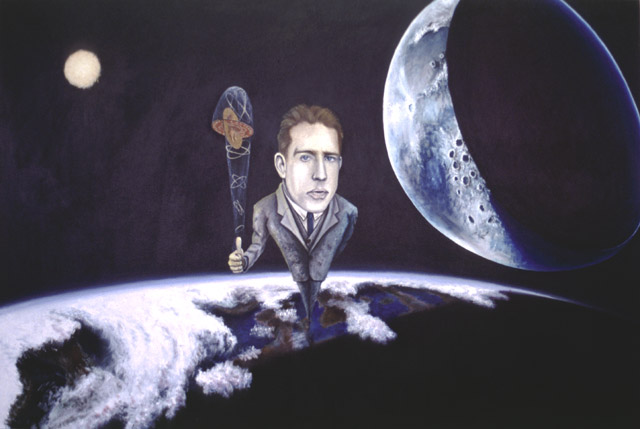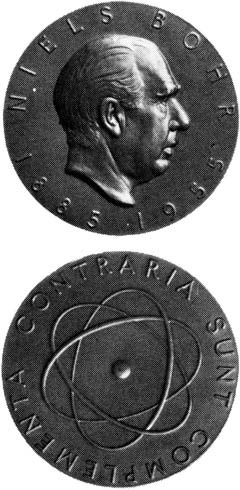| The View
From Kobenhavn is a portrait of physicist/philosopher Niels
Bohr (1883-1955). Born in Kobenhavn (Copenhagen), Denmark,
Bohr became world famous for his contributions to atomic theory.
He was one of the founders of modern quantum physics. Bohr's
Copenhagen Interpretation of quantum mechanics remains the
most widely accepted interpretation of quantum theory to this
day.
One of the major implications
of the Copenhagen interpretation is that we live in a viewer
created
reality. This means that if a tree falls in the forest, and
no one is around to hear it, then it does not make a sound!
Einstein, perhaps the most outspoken opponent of Bohr's interpretation,
was quoted as saying "I believe that the moon is there, even
when I am not looking!" My painting shows Bohr standing on
Kobenhavn and, since the back side of the moon is not visible
from Kobenhavn, it does not exist.
The coin which Bohr is flipping is
in a superposition state. Shortly after being flipped the
wave
function describing the coin bifurcates into a superposition
of the state "heads" and the state "tails." Until the coin
lands and Bohr looks to see which side it is on, it is both
heads and tails simultaneously. This is simmilar to the well
known Schrödinger's Cat Paradox (written by Erwin Schrödinger,
another famous opponent of Bohr's interpretation), where
the cat is both dead and alive until you open the box and
look inside.
If you look closely at the coin, you
will see the phrase "Contraria Sunt Complimenta," meaning
opposites which complement. Complementarity, another major
component
of the Copenhagen Interpretation, was originally used to
explain the wave/particle duality of matter and light, but
Bohr extended
this idea, saying that everything in the universe and in
life has a complement. The coin itself is a reproduction
of the
Niels Bohr medal given by the Danish Association of Engineers,
and originally executed by H. Salomon. |
 |


 |

![]()
